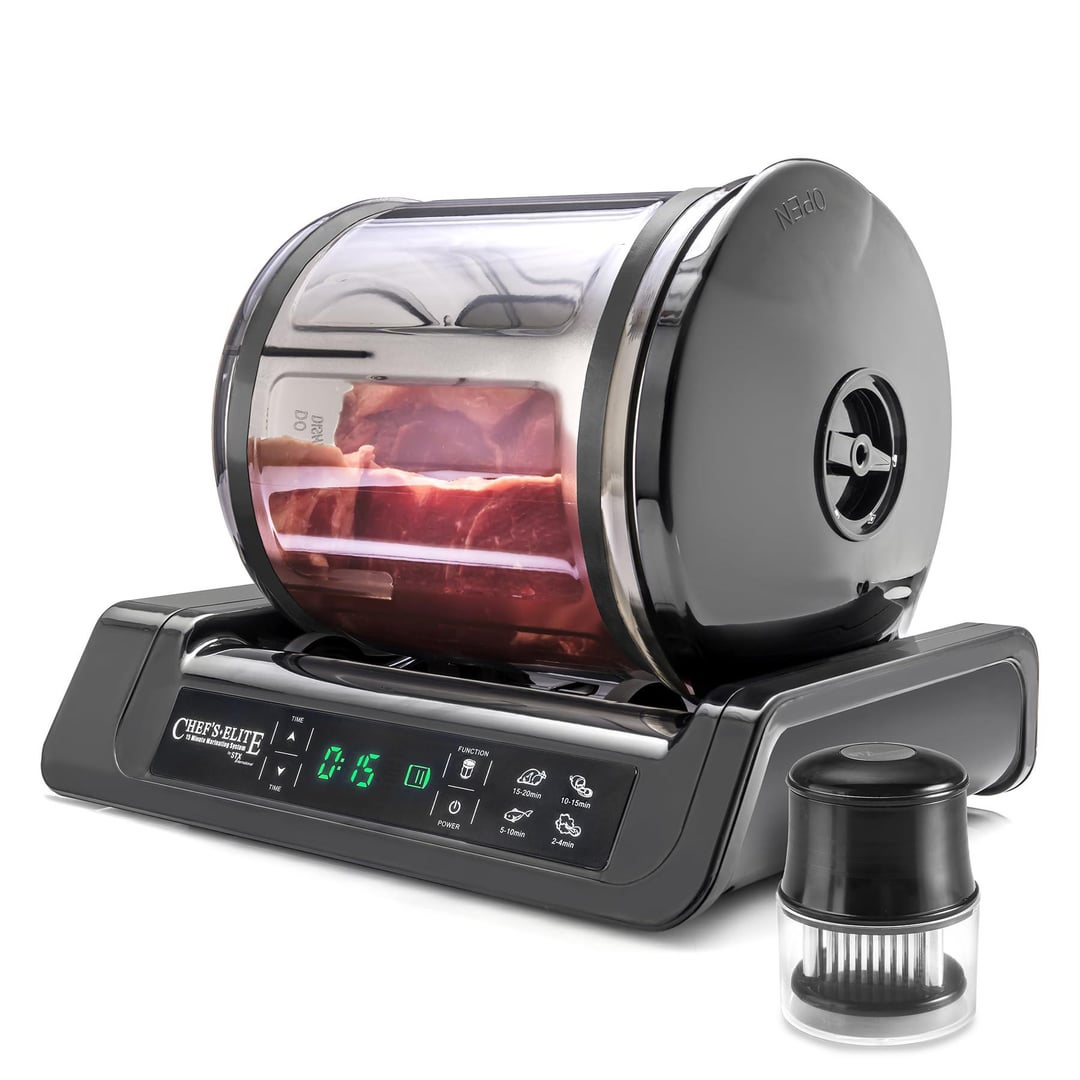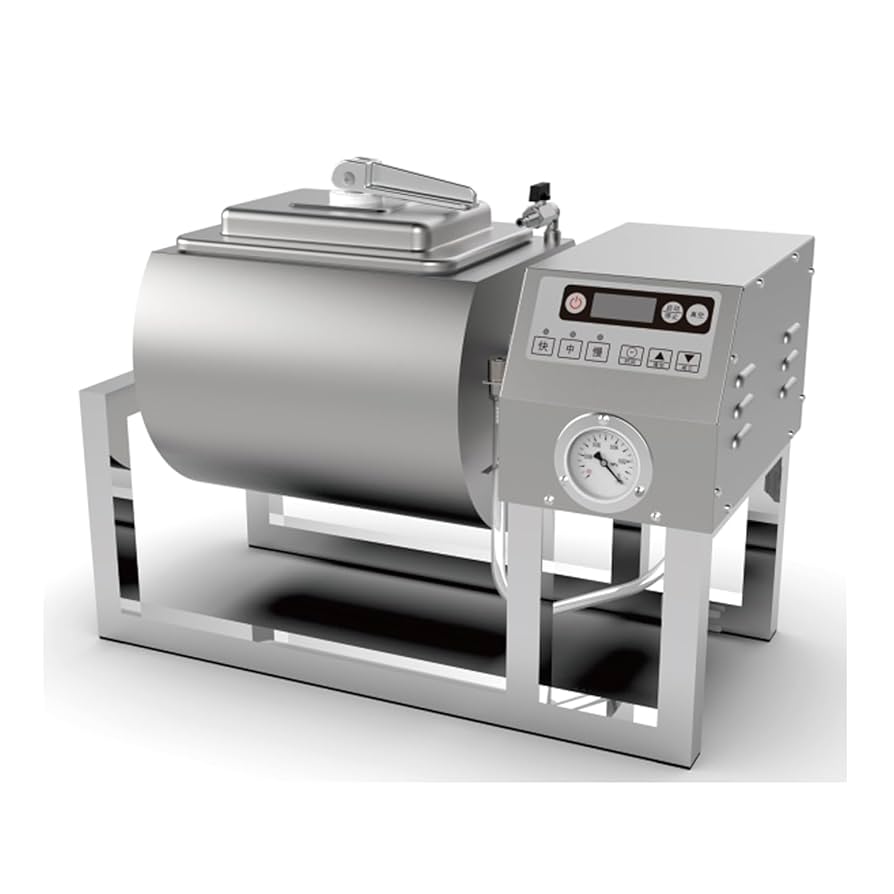10 years of experience as a food machinery equipment manufacturer
10 years of experience as a food machinery equipment manufacturer
The culinary arts have long embraced marination as a fundamental technique for enhancing the flavor and texture of various food items, particularly meats. Traditionally, this process involves soaking food in a seasoned liquid mixture for extended periods, ranging from hours to overnight. While effective to a degree, conventional marination methods often face limitations in terms of time efficiency and depth of flavor penetration. In response to these challenges, innovative kitchen technology has introduced solutions such as the vacuum tumbler meat marinator, a device designed to significantly improve and expedite the marination process.

A vacuum tumbler meat marinator is an appliance engineered to infuse marinades into food products, primarily meats like poultry, beef, pork, and seafood, more rapidly and thoroughly than traditional methods. The core components of such a device typically include a drum or canister to hold the food and marinade, a vacuum pump to remove air from this chamber, and a motor system that rotates or tumbles the drum. These units are commonly constructed from food-grade stainless steel or durable plastics, ensuring hygiene and longevity. The principle of operation combines two key actions: the creation of a vacuum environment and the physical agitation of the food through tumbling.
The efficacy of a vacuum tumbler meat marinator lies in the synergistic effect of its vacuum and tumbling functions. Understanding the science behind these processes illuminates why this technology offers superior results.
The Vacuum Effect: When air is evacuated from the marination chamber, a low-pressure environment is created. This change in pressure has a profound impact on the structure of the meat. Meat, being porous, contains air and moisture within its muscle fibers and interstitial spaces. The removal of ambient air causes the air trapped within the meat to expand and escape. As the vacuum is released, or during the process if it’s intermittent, the marinade is drawn into these newly created voids within the meat’s structure. This is analogous to how a sponge absorbs liquid more effectively when compressed and then allowed to expand. This process significantly accelerates the rate at which the marinade can penetrate deep into the muscle tissues, rather than just coating the surface.
The Tumbling Action: Simultaneous to or alternating with the vacuum process, the drum containing the meat and marinade is gently and continuously rotated. This tumbling action serves multiple purposes. Firstly, it ensures that every piece of meat is uniformly exposed to the marinade, leading to consistent flavor distribution. Secondly, the physical agitation helps to break down and tenderize the muscle fibers of the meat. This mechanical action can make tougher cuts of meat more palatable and succulent. The massaging effect of the tumbling also helps to further open up the meat’s structure, complementing the vacuum’s role in enhancing marinade absorption.
The combination of these two actions – drawing the marinade deep into the meat via vacuum pressure and ensuring even distribution and tenderization through tumbling – results in a dramatically more efficient and effective marination process.
The adoption of vacuum tumbler meat marinators in both commercial and domestic kitchens brings forth a host of benefits:
Vacuum tumbler meat marinators find utility in a diverse range of environments:
Home Kitchens: For culinary enthusiasts, these devices offer a way to elevate everyday meals and special occasion dishes. Barbecue aficionados, in particular, appreciate the ability to quickly and deeply marinate meats for grilling or smoking.
Restaurants and Food Service Establishments: In professional kitchens, where time and consistency are paramount, vacuum tumblers streamline food preparation. They allow chefs to marinate items to order or prepare large batches efficiently, ensuring consistent quality and flavor for their patrons.
Butcher Shops and Delicatessens: These businesses can use vacuum tumblers to create value-added products, such as pre-marinated steaks, chicken pieces, or sausages. This offers convenience to customers and can increase profit margins.

Catering Operations: Caterers often need to prepare large quantities of food. Vacuum tumblers enable them to marinate substantial batches of meat consistently and quickly, which is essential for managing large-scale events.
Food Processing Plants: On an industrial scale, larger vacuum tumbling systems are integral to the production of processed meats, marinated cuts, and ready-to-cook meals, ensuring product uniformity and enhanced shelf life through better marinade integration.
When considering the acquisition of a vacuum tumbler meat marinator, several factors should be taken into account:
Compared to traditional marination methods, such as soaking meat in a bag or dish, the vacuum tumbler offers clear advantages in speed and depth of flavor. While techniques like injection marination can also achieve deep penetration, they may not provide the same level of even distribution or the tenderizing benefits of tumbling. The vacuum tumbler meat marinator effectively combines pressure dynamics and mechanical action to overcome the limitations of older methods.
In conclusion, the vacuum tumbler meat marinator represents a significant advancement in food preparation technology. By leveraging the principles of vacuum pressure and mechanical agitation, it offers a markedly more efficient and effective way to marinate foods. The result is consistently flavorful, tender, and moist products, achieved in a fraction of the time required by conventional techniques. This makes it a valuable asset for anyone serious about enhancing the quality of their marinated dishes, from the home cook to the large-scale food processor.
